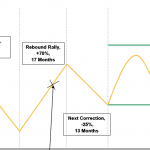OK, its time for round 2, Shedlock vs. Ritholtz.
You may recall that last time, Mish & I disagreed as to whether this was a recession (Me) or a depression (He).
• 1929 Versus 2007: Employment Change
This time, the debate is over the current rally.
On Monday this week on Yahoo Tech Ticker, I discussed that we did not see evidence that the rally was ending (See Rally May Only Be in 6th or 7th Inning, Ritholtz Says).
Shedlock pens a response — Rally in 6th Inning or Top of the 12th? — and discusses the reasons he thinks the market rally should be ending soon: “the flip side of the coin is this market has advanced so far, so fast that if downside momentum does develop, there is nothing but air pockets below. Air pockets are thus a two-way street. If anything, there is far more air below than above.”
That may be. However, none of the various metrics we track suggest the rally is about to run out of gas anytime soon. That doesn’t mean it can’t end tomorrow, but we would rather play the high rather than low probability outcomes.
Here are 5 most reasons why I think we can have more upside, plus a look at some grim economic reality.
1) Individual investors remain under-invested (See Liquidity/Sentiment Review).
2) Market Breadth and momentum are each positive (i.e., supportive of further upside);
3) Sentiment has not (yet) reached extreme levels;
4) The broader investment community believes — incorrectly in my opinion — that a recovery is upon us, profits are getting better.
5) History shows that secular bear markets have deep selloffs and huge rallies; this current rally still has room to run based upon a composite of prior cycles (See Four Stages of Secular Bear Markets).
Now, about that economy. Here is my dirty little secret: FOR ~TWO/THIRDS OF THE TIME, THE ECONOMY REALLY DOES NOT MATTER.
I know that sounds insane, but consider the following: In the middle of secular bull markets, economic info seems to have the greatest correlation with market performance. Good data, more profits, better market action.
At market tops, the economy looks great. Valuations are rich, but record profits support the multiple.
Then it all goes to hell.
At bottoms, it looks awful. It looks like these companies will never make another dime, that layoffs won’t ever end, that we can never escape the tar pit.
And then we do.
This must be perplexing, maddening, infuriating to pure economists. But that is Mr.Market’s job — to frustrate the maximum number of players . . .



What's been said:
Discussions found on the web: